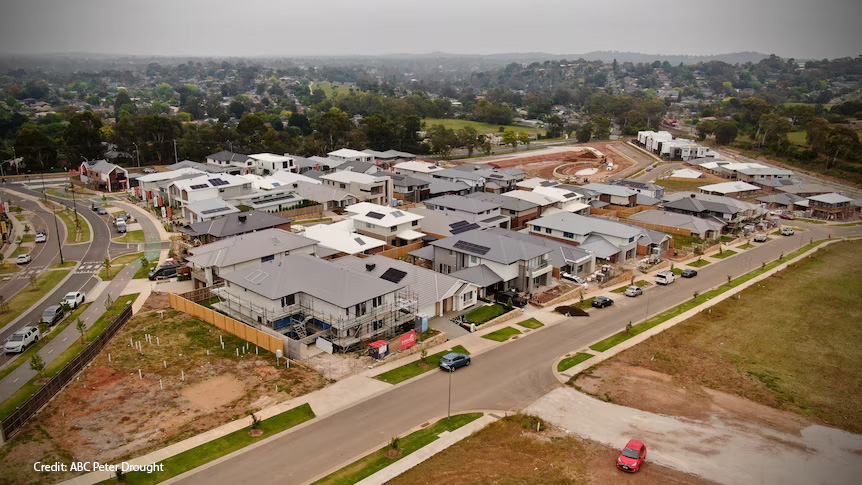
Australia's Housing Crisis Is A Massive Opportunity
Australia's Housing Crisis Is A Massive Opportunity
Australia's Housing Crisis Creates Massive Financing Opportunity
NSW promised 112,000 homes and delivered 11,564 in the December quarter.
That's a shortfall that exposes where the real bottleneck sits. Meanwhile, Australia faces an accumulated housing supply shortfall of 179,000 dwellings since 2022 alone. It's not planning approvals anymore. It's financing.
Having spent over two decades in financial services and technology, building everything from foreign exchange platforms to wealth management systems, this financing gap represents the biggest commercial opportunity in Australian property since deregulation.
The NSW government's Low and Mid-Rise policy promises 112,000 homes over five years, yet NSW delivered only 11,564 homes against a 19,600 quarterly benchmark needed just to meet Housing Accord targets. Development applications jumped 28% year-on-year, yet completions collapsed.
Government fixed the permission problem. Now we need to fix the delivery problem.
Why Traditional Banks Are Slow in the Missing Middle
Medium-density projects sit in financing no-man's land. Too big for residential mortgages, too small for institutional commercial lending. Traditional banks view these through regulatory frameworks designed for different asset classes entirely.
Banks need comparable sales data that doesn't exist. Medium-density projects often represent first-of-type developments in established suburbs. No comparables equals no financing approval, regardless of project fundamentals.
Regulatory capital requirements force banks to treat these projects as high-risk despite construction economics that make them among the safest development types to finance.
Meanwhile, developers sit with approved projects worth billions they cannot fund through traditional channels. The financing crisis runs deeper than most realise. ASIC data shows 2,975 construction company insolvencies in 2023-24, accounting for 27% of all business failures nationally. When your construction partners are collapsing at this rate, traditional bank risk models break down completely.
The Economics Stack Up Without Banking Constraints
Missing middle developments cost significantly less to build than high-rise alternatives. Low-rise, wood-frame construction avoids expensive concrete podiums and allows local contractors to participate rather than requiring specialised high-rise expertise.
NSW's $1 billion Pre-sale Guarantee program backs 50% of eligible units, essentially providing the market validation banks claim they need. Yet traditional banking infrastructure still cannot process these opportunities at market speed.
The construction economics work. The financing infrastructure doesn't.
This creates exactly the type of market inefficiency that rewards first movers who can solve the connection problem between abundant global capital and shovel-ready Australian projects.
Digital Platforms Bridge the Capital Gap
Global capital markets contain enormous liquidity seeking precisely these risk-adjusted returns. The challenge is connection, not availability.
Digital financing platforms standardise due diligence processes that currently take banks months to complete. Automated KYC verification, standardised documentation, and global lender networks compress financing timelines from quarters to weeks.
Technology solves the comparable sales problem through data analytics that assess projects based on broader market indicators rather than hyperlocal precedents. Global financing experience provides risk assessment frameworks that local banks lack.
The Scale of Opportunity
Australia requires one million new homes by 2029 under the National Housing Accord, with the Property Council projecting a supply deficit of 106,000 homes by 2027 just to meet population growth. NSW alone needs 75,300 homes per year. Current delivery rates suggest this gap will widen dramatically over the next five years.
For CFOs evaluating residential development exposure, the risk profile has fundamentally shifted. Government policy removes planning constraints. Market demand provides clear exit strategies. Construction costs remain manageable for missing middle projects.
For commercial mortgage brokers, this represents a structural shift in deal flow. Traditional bank relationships won't solve financing for projects that don't fit existing lending criteria.
For real estate investors, the financing bottleneck creates temporary market inefficiency that rewards platforms capable of connecting global capital to local opportunities.
For lenders, Australian residential development offers compelling risk-adjusted returns with government backing, established demand, and manageable construction profiles.
First Mover Advantage
Traditional banking will eventually adapt to these market requirements. The question is timeline. Banks modify risk assessment frameworks and regulatory processes slowly. Digital platforms move at market speed.
The developers, brokers, and lenders who solve financing access first will capture disproportionate market share in Australia's largest housing construction cycle since the 1970s.
Having built technology platforms that processed billions in transactions across multiple jurisdictions, I can confirm the infrastructure exists to solve this financing gap today.
The financing bottleneck that created the delivery problem represents the market opportunity that will define the next decade of Australian residential development.
The question for industry participants is whether they'll wait for traditional banking to catch up, or position themselves ahead of the curve.
References
1. Institute of Public Affairs: Australia's post-pandemic housing shortfall balloons to 179,000
2. NSW Government: Low and Mid-Rise policy to unlock 112,000 homes in five years
3. ASIC: Annual ASIC insolvency data reveals increase in companies failing
4. Australian Treasury: Delivering the National Housing Accord
5. Property Council of Australia: Housing shortage set to worsen
6. National Housing Supply and Affordability Council: State of the Housing System 2024
7. RealEstate.com.au: ASIC records 3000+ construction sector insolvencies in 2024
8. Australian Local Government Association: Addressing the Housing Crisis report

